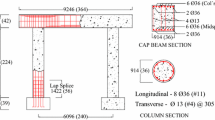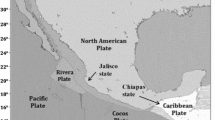Abstract
Probabilistic performance assessment requires the development of probability distributions that can predict different performance levels of structures with reasonable accuracy. This study evaluates the performance of a non-seismically designed multi-column bridge bent retrofitted with four different alternatives, and based on their performance under an ensemble of earthquake records it proposes accurate prediction models and distribution fits for different performance criteria as a case study. Here, finite element methods have been implemented where each retrofitting technique has been modeled and numerically validated with the experimental results. Different statistical distributions are employed to represent the variation in the considered performance criteria for the retrofitted bridge bents. The Kolmogorov-Smirnov goodness-of-fit test was carried out to compare different distributions and find the suitable distribution for each performance criteria. An important conclusion drawn here is that the yield displacement of CFRP, steel, and ECC jacketed bridge bents are best described by a gamma distribution. The crushing displacement and crushing base shear of all four retrofitted bent follow a normal and Weibull distribution, respectively. A probabilistic model is developed to approximate the seismic performance of retrofitted bridge bents. These probabilistic models and response functions developed in this study allow for the performance prediction of retrofitted bridge bents.

















Similar content being viewed by others
References
Alam MS, Youssef MA, Nehdi M (2008) Analytical prediction of the seismic behaviour of superelastic shape memory alloy reinforced concrete elements. Eng Struct 30(12):3399–3411
Alam MS, Youssef MA, Nehdi M (2009) Seismic performance of concrete frame structures reinforced with superelastic shape memory alloys. Smart Struct Syst 5(5):565–585
Berry M, Eberhard M (2003) Performance models for flexural damage in reinforced concrete columns. PEER 2003/18, Pacific Earthquake Engineering Research Center, Berkeley, CA
Billah AHMM, Alam MS (2012) Seismic performance of SMA-FRP RC hybrid column with adequate ductility and energy dissipation capacity. Constr Building Mater 28(1):730–742
Billah AHMM, Alam MS (2013) Performance-based prioritization for seismic retrofitting of RC bridge bents. Struct Infrastruct Eng. doi:10.1080/15732479.2013.772641 (in press)
Billah AHMM, Alam MS, Bhuiyan AR (2013) Fragility analysis of retrofitted multi-column bridge bent subjected to near fault and far field ground motion. ASCE J Bridge Eng. doi:10.1061/(ASCE)BE.1943-5592.0000452 (in press)
Conover WJ (1971) Practical nonparametric statistics. Wiley, New York
D’Agostino RB, Stephens MA (eds) (1986) Goodness-of-fit techniques. Marcel Dekker, New York 560
ElGawady M, Endeshaw M, McLean D, Sack R (2010) Retrofitting of rectangular columns with deficient lap splices. J Compos Constr ASCE 14(1):22–35
Elnashai AS, Papanikolaou V, Lee D (2002) Zeus NL—a system for inelastic analysis of structures. Mid-America Earthquake Center, University of Illinois at Urbana-Champaign, Program Release, Sept. 2002
Filippou FC, Popov EP, Bertero VV (1983) Modelling of R/C joints under cyclic excitations. ASCE J Struct Eng 109(11):2666–2684
Ferracuti B, Savoia M (2005) Cyclic behaviour of FRP-wrapped columns under axial and flexural loadings. In: Proceedings of the international conference on fracture, Turin, Italy
FHWA-HRT-06-032 (2006) Seismic retrofitting manual for highway structures: part 1—Bridges. Research, Development, and Technology, Turner-Fairbank, Highway Research Center 6300, Georgetown Pike McLean, VA 22101–2296
Gencturk B, Elnashai AS (2011) Multi-objective optimal seismic design of buildings using advanced engineering materials. MAE Center report no. 11–01, Department of Civil and Environmental Engineering, University of Illinois at Urbana-Champaign, Urbana, Illinois
Han TS, Feenstar PS, Billington SL (2003) Simulation of highly ductile fiber-reinforced cement-based composite components under cyclic loading. ACI Struct J 100(6):749–757
Hose Y, Silva P, Seible F (2000) Development of a performance evaluation database for concrete bridge components and systems under simulated seismic loads. Earthq Spectra 16(2):413–442
King RL (1987) The determination of design allowable properties for advanced composite materials. GEC J Res 5(2)
Li VC (2008) Engineered cementitious composites (ECC)—material, structural, and durability performance. In: Nawy E (ed) Concrete construction engineering handbook, Chapter 24, CRC Press
Li V, Horii H, Kabele P, Kanda P, Lim YM (2000) Repair and retrofit with engineered cementitious composites. Eng Fract Mech 65:317–334
Luco N, Cornell CA (1998) Effects of random connection fractures on the demands and reliability for a three-story pre-Northridge (SMRP) structure. In: Proceedings of the sixth U.S. national conference on earthquake Engineering, Earthquake Engineering Research Institute, Oakland, California
Mander JB, Priestley MJN, Park R (1988) Theoretical stress-strain model for confined concrete. J Struct Eng 114(8):1804–1826
Madas P, Elnashai AS (1992) A new passive confinement model for transient analysis of reinforced concrete structures. Earthq Eng Struct Dyn 21:409–431
Menegotto M, Pinto PE (1973) Method of analysis for cyclically loaded R.C. plane frames including changes in geometry and non-elastic behaviour of elements under combined normal force and bending. In: Symposium on the resistance and ultimate deformability of structures acted on by well defined repeated loads. International Association for Bridge and Structural Engineering, Zurich, Switzerland, pp 15–22
Mood MA, Graybill FA, Boes DC (1974) Introduction to the theory of statistics, 3rd edn. McGraw-Hill, New York
NIST/SEMATECH e-handbook of statistical methods, July 2012. http://www.itl.nist.gov/div898/handbook/ (2010)
Pantelides CP, Gergely J (2002) Carbon-fiber-reinforced polymer seismic retrofit of RC bridge bent: design and in situ validation. J Compos Constr 6(1):52–60
Pinho R, Casarotti C, Antoniou S (2007) A comparison of single-run pushover analysis techniques for seismic assessment of bridges. EarthquakeEng Struct Dyn 36:1347–1362
Priestley MJN, Seible F, Calvi GM (1994) Seismic design and retrofit of bridges. Wiley, New York
Seismostruct V5.2.5 (2011) www.seismosoft.com
Snedecor WG, Cochran WG (1989) Statistical methods, 8th edn. Iowa State University press, Iowa
Spoelstra M, Monti G (1999) FRP-confined concrete model. J Compos Constr ASCE 3:143–150
Tsonos AG (2009) Ultra-high performance fiber reinforced concrete: an innovative solution for strengthening old R/C structures and for improving the FRP strengthening method. Mater Charact Comput Methods Exp IV. WIT Trans Eng Sci 64. doi:10.2495/MC090261
USGS, Geological Hazards Science Center, Hazard Curve Application, available online: http://geohazards.usgs.gov/hazardtool/application.php. Accessed January 2012
Vamvatsikos D, Cornell CA (2002) Incremental dynamic analysis. Earthq Eng Struct Dyn 31(3):491–514
Vandoros KG, Dritsos SE (2008) Concrete jacket construction detail effectiveness when strengthening RC columns. Constr Building Mater 22:264–276
Wagner HD, Phoenix SL, Schwartz P (1984) A study of statistical variability in the strength of single aramid filaments. J Compos Mater 18(4):312–338
Yankelevsky DZ, Reinhardt HW (1989) Uniaxial behaviour of concrete in cyclic tension. J Struct Eng ASCE 115(1):166–182
Yun S, Hamburger RO, Cornell CA, Foutch DA (2002) Seismic performance evaluation for steel moment frames. J Struct Eng ASCE 128(4):534–545
Zeus NL (2011) A system for inelastic analysis of structure, V-1.8.9. Mid America Earthquake Centre
Zhang J, Foschi RO (2004) Performance-based design and seismic reliability analysis using designed experiments and neural networks. Probab Eng Mech 19(3):259–267
Acknowledgments
The financial contribution of Natural Sciences and Engineering Research Council (NSERC) of Canada through Engage Program was critical to conduct this research and is gratefully acknowledged.
Author information
Authors and Affiliations
Corresponding author
Rights and permissions
About this article
Cite this article
Billah, A.H.M.M., Alam, M.S. Statistical distribution of seismic performance criteria of retrofitted multi-column bridge bents using incremental dynamic analysis: a case study. Bull Earthquake Eng 11, 2333–2362 (2013). https://doi.org/10.1007/s10518-013-9467-y
Received:
Accepted:
Published:
Issue Date:
DOI: https://doi.org/10.1007/s10518-013-9467-y




